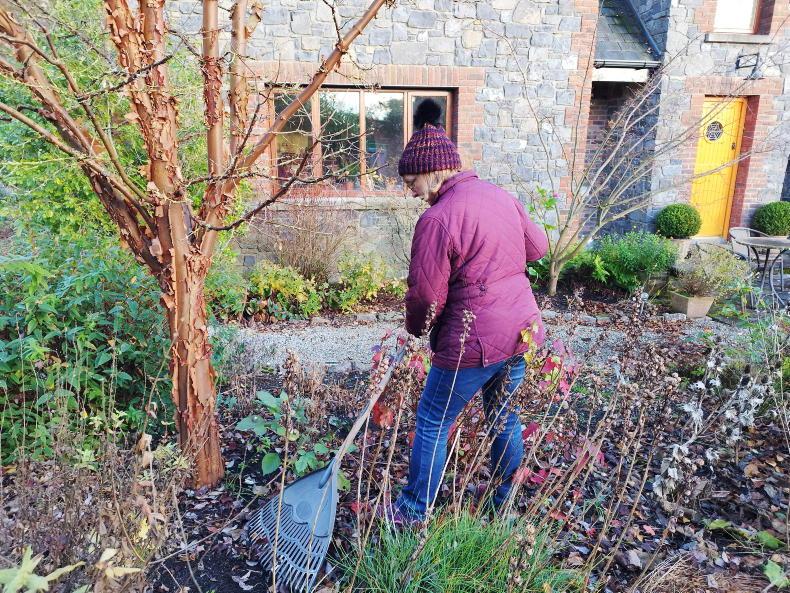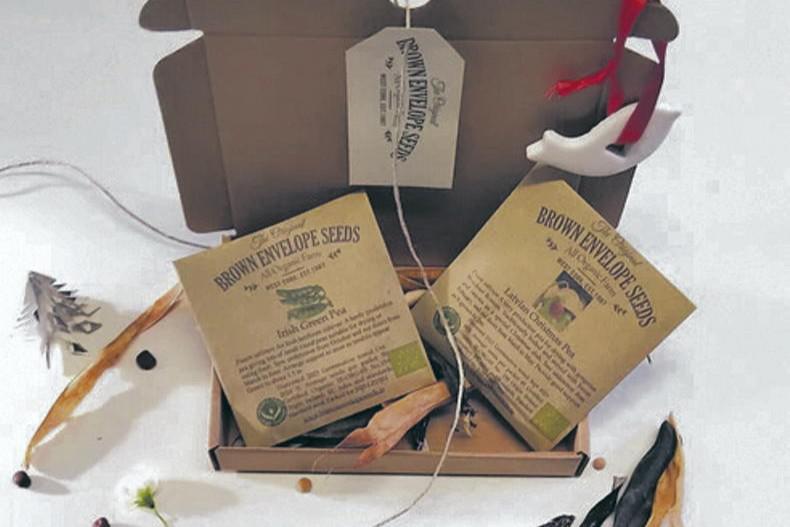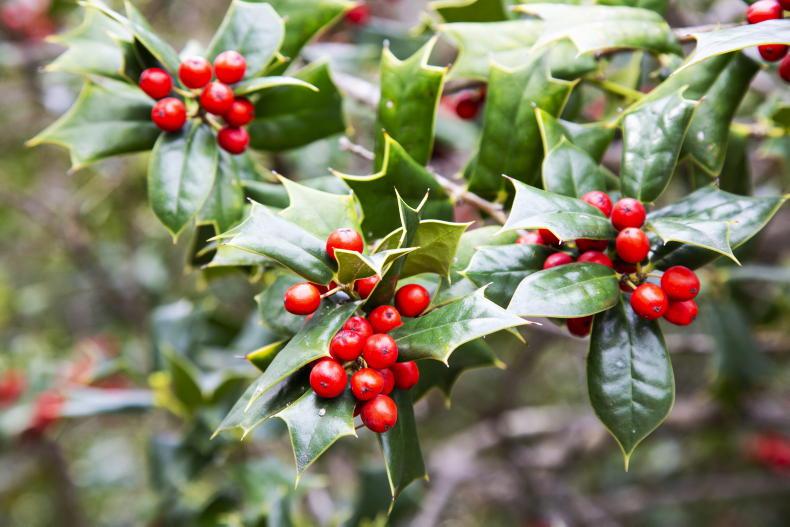At this time of year, dominated by preparations for the festive period ahead, taking a bit of time out to garden can be a welcome reprieve from all the hustle and bustle.
Our small front garden and areas of our larger garden that are close to the house will get a spruce up over the next week or so to have them looking tidy and welcoming for visitors over Christmas.
Fallen, soggy leaves are raked off the paths and out of the borders and these are gathered and composted separately from other garden waste to make a leaf mould. The faded stems of perennials that bloomed in summer are now cut back to ground level.
Those with attractive seedheads, such as Sedum ‘Autumn Joy’ and Eryngium giganteum are left in situ to provide interest and charm, especially when they become encrusted with sparkling frost.
Three key plants for winter interest are cleared around to show off their colourful bark. These include the cinnamon-coloured paperbark maple, Acer griseum, a green-and-white-striped snakebark maple, Acer davidii ‘Serpentine’, and a yellow-stemmed dogwood, Cornus sericea ‘Flavirimea’.

The tiny, creamy white flowers of Sarcococca confusa, also known as Christmas box, fill the air with their sweet scent from December to March.
Just inside our pedestrian front gate, a Christmas box, Sarcococca confusa, lies in wait to engulf visitors in the powerful, sweet perfume from its tiny, tassel-like white flowers. This compact, evergreen shrub is suitable for any size garden and prefers a shaded spot.
We will also plant up a few containers and group them together for colourful and welcoming displays alongside the front door over the festive season.
Trailing ivies, winter-flowering heathers, small skimmias, violas and pansies are some of our favourite plants to use for winter containers.
As finishing touches, we will hang a Christmas wreath made from evergreen foliage, seedheads and berries, all from our own garden, on the front door and trace the outline of the branches of the paperbark maple with some twinkling, warm white lights.

Mary Keenan's Christmas tree.
Make your Christmas tree last
In our house, putting up the Christmas tree is a family event that usually takes place during the second week in December.
If you’re opting for a real tree in your house this year, you’ll want to make sure it stays fresh throughout the festive season. Real Christmas trees have an average life span of four to five weeks in the home, if cared for properly. Nordmann fir and noble fir are popular choices — both have good needle retention and strong branches for hanging heavy decorations. When shopping for your tree, select one that looks fresh and healthy with bright, shiny needles. It should also have a full shape, and be sure to give it a little shake — if the needles don’t drop off, that’s a good sign.
As soon as you get home, and before setting up your tree, you should saw around 5cm off the base of the trunk. This is to get rid of any dried-over resin that might block the trunk from absorbing water. Put the tree in a bucket of water outside overnight, or ideally for a day or two, before moving it indoors. Your tree should sit in a stand that holds water and fill it up immediately after it is secured. Keep it hydrated by topping up with a minimum of 500ml of water every day. Place the tree away from direct heat, such as an open fire, stove or a radiator.
After the festive season, many councils will collect Christmas trees for recycling or shred the branches yourself for use as a weed-suppressing mulch in your garden.
Plant bare-root trees and shrubs
Many woody plants, like fruit trees, specimen ornamental trees, roses, soft fruit bushes and deciduous hedging, are supplied from some nurseries and garden centres as bare-rooted plants for planting during the winter-dormant period between November and February.
Planting bare-root is cheaper, easier and faster than planting container-grown plants and if you have a large planting project, such as lots of trees or a hedge, it can cut your costs substantially.
It is essential that the roots of a bare-root plant don’t dry out, either before or during planting, so you must get them into the ground as soon as you can. Before planting, soak the roots thoroughly, then plant into well-prepared soil.
Look for the original soil mark on the plant’s stem and plant to the same depth as it was in the nursery. If you can’t plant immediately — if the soil is frozen or waterlogged, for example — heel bare-rooted plants in until the weather improves.
Simply dig a hole in a cool, sheltered spot, sit the bundles into it and backfill so the roots are covered, keeping them moist but not saturated, until planting time.
You can delay planting for a few weeks like this, but the plants must be in their permanent planting position before the buds begin to swell.
Repair and treat fencing and other timber supports while climbers are dormant.
Night-time temperatures can drop sharply in December so keep some horticultural fleece to hand to provide protection for tender plants against damage on frosty nights.
Collect any fallen leaves that are smothering alpines and other low-growing plants. Left in place, these will form a solid mass that will exclude light and cause rotting.
Trim ivy, Virginia creeper and other climbing plants from around gutters and downpipes. Snip them back from windows, door frames and the edges of roofing tiles too.
Move deciduous trees and shrubs that are growing in the wrong place, or have outgrown their space, to a new position, if they are small enough to handle. Try to lift them with as large a rootball as possible.
Monday 11 December: Cullohill and Durrow Flower Club Charity Christmas Floral Demonstration by Melanie Harris, AOIFA. Time: 8pm. Venue: Castle Arms Hotel, Durrow, Co Laois. Admission €15 including mulled wine and mince pies.
Mary Keenan and Ross Doyle run Gash Gardens, Co. Laois open to the public. gashgardens.ie.
Read more
Mary Keenan's Garden Diary: Terrace time
Mary Keenan's Garden Diary: mind the gaps
At this time of year, dominated by preparations for the festive period ahead, taking a bit of time out to garden can be a welcome reprieve from all the hustle and bustle.
Our small front garden and areas of our larger garden that are close to the house will get a spruce up over the next week or so to have them looking tidy and welcoming for visitors over Christmas.
Fallen, soggy leaves are raked off the paths and out of the borders and these are gathered and composted separately from other garden waste to make a leaf mould. The faded stems of perennials that bloomed in summer are now cut back to ground level.
Those with attractive seedheads, such as Sedum ‘Autumn Joy’ and Eryngium giganteum are left in situ to provide interest and charm, especially when they become encrusted with sparkling frost.
Three key plants for winter interest are cleared around to show off their colourful bark. These include the cinnamon-coloured paperbark maple, Acer griseum, a green-and-white-striped snakebark maple, Acer davidii ‘Serpentine’, and a yellow-stemmed dogwood, Cornus sericea ‘Flavirimea’.

The tiny, creamy white flowers of Sarcococca confusa, also known as Christmas box, fill the air with their sweet scent from December to March.
Just inside our pedestrian front gate, a Christmas box, Sarcococca confusa, lies in wait to engulf visitors in the powerful, sweet perfume from its tiny, tassel-like white flowers. This compact, evergreen shrub is suitable for any size garden and prefers a shaded spot.
We will also plant up a few containers and group them together for colourful and welcoming displays alongside the front door over the festive season.
Trailing ivies, winter-flowering heathers, small skimmias, violas and pansies are some of our favourite plants to use for winter containers.
As finishing touches, we will hang a Christmas wreath made from evergreen foliage, seedheads and berries, all from our own garden, on the front door and trace the outline of the branches of the paperbark maple with some twinkling, warm white lights.

Mary Keenan's Christmas tree.
Make your Christmas tree last
In our house, putting up the Christmas tree is a family event that usually takes place during the second week in December.
If you’re opting for a real tree in your house this year, you’ll want to make sure it stays fresh throughout the festive season. Real Christmas trees have an average life span of four to five weeks in the home, if cared for properly. Nordmann fir and noble fir are popular choices — both have good needle retention and strong branches for hanging heavy decorations. When shopping for your tree, select one that looks fresh and healthy with bright, shiny needles. It should also have a full shape, and be sure to give it a little shake — if the needles don’t drop off, that’s a good sign.
As soon as you get home, and before setting up your tree, you should saw around 5cm off the base of the trunk. This is to get rid of any dried-over resin that might block the trunk from absorbing water. Put the tree in a bucket of water outside overnight, or ideally for a day or two, before moving it indoors. Your tree should sit in a stand that holds water and fill it up immediately after it is secured. Keep it hydrated by topping up with a minimum of 500ml of water every day. Place the tree away from direct heat, such as an open fire, stove or a radiator.
After the festive season, many councils will collect Christmas trees for recycling or shred the branches yourself for use as a weed-suppressing mulch in your garden.
Plant bare-root trees and shrubs
Many woody plants, like fruit trees, specimen ornamental trees, roses, soft fruit bushes and deciduous hedging, are supplied from some nurseries and garden centres as bare-rooted plants for planting during the winter-dormant period between November and February.
Planting bare-root is cheaper, easier and faster than planting container-grown plants and if you have a large planting project, such as lots of trees or a hedge, it can cut your costs substantially.
It is essential that the roots of a bare-root plant don’t dry out, either before or during planting, so you must get them into the ground as soon as you can. Before planting, soak the roots thoroughly, then plant into well-prepared soil.
Look for the original soil mark on the plant’s stem and plant to the same depth as it was in the nursery. If you can’t plant immediately — if the soil is frozen or waterlogged, for example — heel bare-rooted plants in until the weather improves.
Simply dig a hole in a cool, sheltered spot, sit the bundles into it and backfill so the roots are covered, keeping them moist but not saturated, until planting time.
You can delay planting for a few weeks like this, but the plants must be in their permanent planting position before the buds begin to swell.
Repair and treat fencing and other timber supports while climbers are dormant.
Night-time temperatures can drop sharply in December so keep some horticultural fleece to hand to provide protection for tender plants against damage on frosty nights.
Collect any fallen leaves that are smothering alpines and other low-growing plants. Left in place, these will form a solid mass that will exclude light and cause rotting.
Trim ivy, Virginia creeper and other climbing plants from around gutters and downpipes. Snip them back from windows, door frames and the edges of roofing tiles too.
Move deciduous trees and shrubs that are growing in the wrong place, or have outgrown their space, to a new position, if they are small enough to handle. Try to lift them with as large a rootball as possible.
Monday 11 December: Cullohill and Durrow Flower Club Charity Christmas Floral Demonstration by Melanie Harris, AOIFA. Time: 8pm. Venue: Castle Arms Hotel, Durrow, Co Laois. Admission €15 including mulled wine and mince pies.
Mary Keenan and Ross Doyle run Gash Gardens, Co. Laois open to the public. gashgardens.ie.
Read more
Mary Keenan's Garden Diary: Terrace time
Mary Keenan's Garden Diary: mind the gaps











SHARING OPTIONS